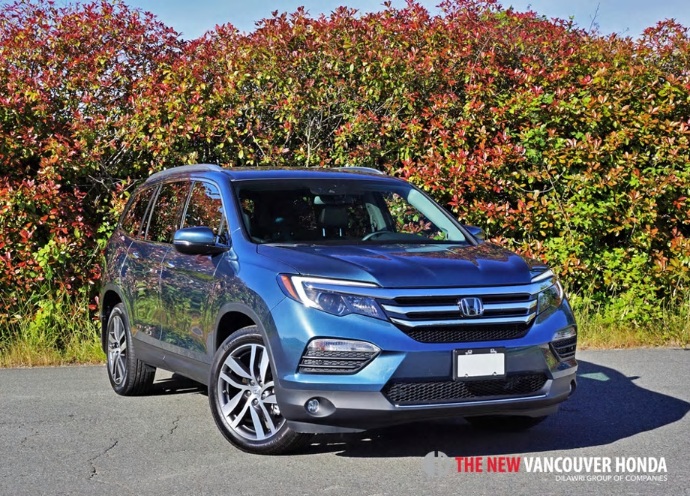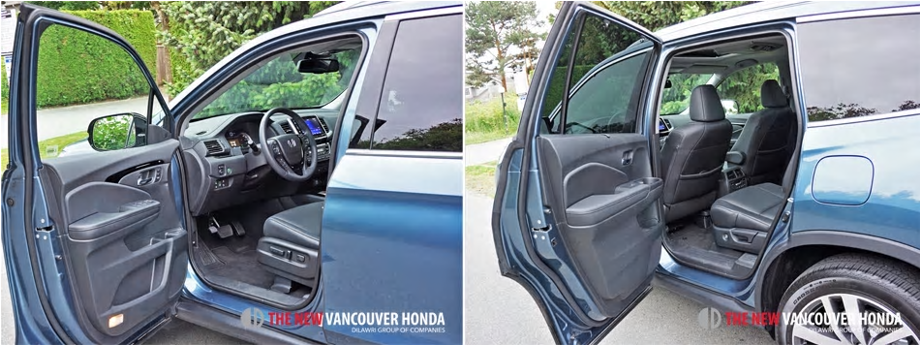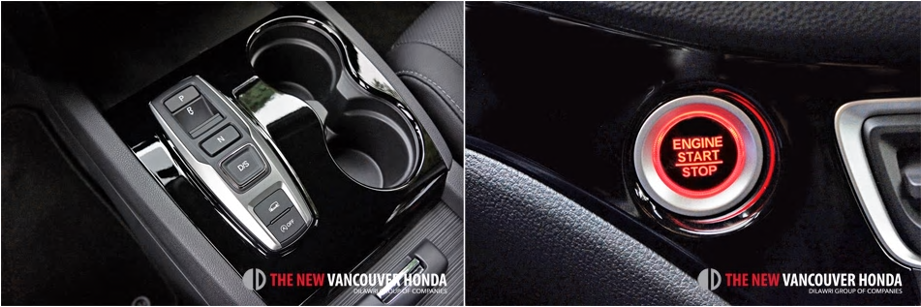2017 Honda Pilot Touring Road Test Review
August 22 2017,

A Technologically Advanced Family Hauler
Strangely, Honda gave me the exact same Pilot Touring to test for the 2017 model year as it did for 2016. Both were finished in a grey-blue Steel Sapphire Metallic paint and black leather combination. I can understand why, as it looks plenty classy suited up like this. Then again with so many other colours available, such as darker and bolder Obsidian Blue Pearl, dark green Black Forest Pearl, Dark Cherry Pearl, and all the usual shades from White Diamond Pearl, Lunar Silver Metallic, and medium grey Modern Steel Metallic, to Crystal Black Pearl, something different would've benefited our 2017 photo gallery.
Interestingly, the Pilot comes standard with as many seats as it does available exterior colours, eight, although the second-row captain's chairs in our tester resulted in the usual count of seven seats from its three rows. The first two rows are as sizeable as SUVs get, with the 10-way power-adjustable two up front allowing almost any body type to fit in and get comfortable. They're three-way heated and cooled in Touring trim too, whereas the second-row seats are heatable. When more than four come along for the ride, accessing the third row is almost effortless. Just press one of the buttons on the side or rear of the second row buckets and voila, they'll automatically slide forward for wide, easy entry to a third row that's more accommodating than most in this class.
Comfortable and Roomy for Passengers and Cargo
If you want to fold the second-row seats down completely, just pull up on the lever below the cushion. The rearmost seats fold by pulling on a strap that also flips down the headrest automatically, an easy process that doesn't take much effort to execute. This opens up 524 litres of available cargo space behind the 60/40 split-folding third row in all but Touring trim, which gets a slight reduction to 510 litres. I'm not counting the storage compartment under the load floor either, which is handy for stowing dirty gloves, rags, or alternatively valuables that might be best hidden away, while lowering that third row opens the Pilot's cargo capacity up to 1,583 litres in lower trims and 1,557 litres for the Touring, and dropping both rear rows results in 3,092 litres of available cargo space in the former and 3,072 litres in the latter. Either way, that's a lot of available cargo space.
Back up front, two of the Pilot's best attributes are its bright, colourful and easy-to-read analogue and digital primary instrument cluster and its large 8.0-inch infotainment touchscreen. Instead of older style analogue knobs and buttons on one side of the latter interface or both, it gets a user-friendly row of touch-sensitive quick-access controls on the blackened out left portion, including a volume slider. I like the sophisticated look of the purely touch-sensitive interface and certainly didn't have any problem using it. Likewise, the display graphics are big and easy to figure out, the colours rich and contrast deep, resulting in a premium-level experience.
Infotainment System Delivers a High-Tech yet User-Friendly Experience
The best part is it's standard Pilot kit, the infotainment system's list of functions including Apple CarPlay and Android Auto smartphone connectivity, a multi-angle backup camera with dynamic guidelines, SMS text message and email functionality, wireless smartphone connectivity with audio streaming, Wi-Fi, Siri Eyes Free, and control of a 225-watt AM/FM/CD audio system with seven speakers including a sub, speed-sensitive volume control, satellite radio, three USB ports, an aux input, and active noise cancellation. Touring trim adds accurate navigation with nicely detailed mapping, while the audio is upgraded to a superb sounding 540-watt system with 5.1 surround sound, 10 speakers plus a sub, HD radio, and five USB ports, four of which have 2.5-amp capacity for charging tablets. Lastly, a Blu-ray rear entertainment system with a 9.0-inch ceiling-mounted display, two wireless headphones, an HDMI input, and a 115-volt household-style power outlet gets added for those in back.
Now that I'm talking features, some additional Touring items include standard 20-inch alloys, full LED headlamps with auto-leveling and auto high beams, chromed exterior door handles, acoustic front door glass, ambient interior lighting, rain-sensing wipers, driver's side memory including the seats and side mirrors, the latter also power-folding and incorporating reverse tilt-down, while the Touring list continues with upgraded perforated leather upholstery, ventilated front seats, second-row captain's chairs, a double-pane panoramic glass sunroof, second-row sunshades, blindspot monitoring with rear cross-traffic alert, etcetera.
I'd be remiss if I didn't include a shortlist of features pulled up from lesser trims, which are fewer now than last year thanks to the elimination of the base LX FWD, the new base LX AWD model's inclusion of the Honda Sensing active safety suite as standard, and EX-L trim now including standard navigation or a rear-seat entertainment system. Back to that base LX AWD model, the standard menu remains impressive with auto on/off headlamps, LED daytime running lights, fog lights, turn signals integrated into the side mirror housings, LED taillights, a windshield wiper de-icer, an acoustic windshield, roof rails, heatable power-actuated side mirrors, remote start, proximity-sensing keyless access with pushbutton ignition, a heatable leather-wrapped steering wheel, a colour TFT multi-information display, a sunglasses holder that doubles as a conversation mirror, an auto-dimming rearview mirror, a universal garage door opener, dynamic cruise control, tri-zone auto climate control with second-row controls, heatable front seats, a 10-way powered driver's seat, a powered front passenger seat, heated second-row outboard seats, one-touch folding second-row seats, front and rear parking sensors, a powered tailgate, and much more.
Standard Pilot Safety Features Are Second to None
Many of the features just mentioned are standard Pilot gear, but probably most impressive are all of the passive and active safety systems integrated into the base model and therefore standard across the entire Pilot line, which along with the usual ABS-enhanced four-wheel discs, electronic brake-force distribution, brake assist, traction and stability control, hill start assist, trailer stability assist, tire pressure monitoring, and emergency response telematics include the aforementioned Honda Sensing advanced driver-assistance system, which incorporates forward collision warning, collision mitigating autonomous braking, lane departure warning, lane keeping assist, and road departure mitigation, and more. Honda's superb LaneWatch blindspot display system, which uses a rearward facing camera on the passenger-side mirror to project live video of the blindspot when activating the right turn signal, isn't standard or available when blindspot monitoring with rear cross-traffic assist is chosen, which comes as part of the Touring model I drove, so alas one of the coolest features offered in any vehicle wasn't included. As you may have guessed all of this safety gear earned the 2017 Pilot a best-possible IIHS Top Safety Pick Plus rating, whereas the NHTSA honoured it with an equally impressive five stars for safety.
While the Pilot's standard safety kit is brilliantly good, you'll need to move up to Touring trim in order to take advantage of its top-line drivetrain. To be clear, Honda's well-proven direct-injection 3.5-litre V6 is the same through the line. It's capable of a hearty 280 horsepower and 262 lb-ft of torque for reasonably good response off the line and commendable highway passing power, but then again I can only speak for the Touring model, as I haven't driven the others. Touring trim gets upgraded to Honda's new nine-speed automatic transmission with pushbutton gear selection and sporty steering wheel paddle shifters, while all trims below get a reliable albeit not quite so state-of-the-art six-speed autobox. The engine gets Honda's Variable Cylinder Management system either way, which shuts down three of its six cylinders to save fuel when coasting, while all trims also receive the brand's Eco Assist system to further reduce consumption, but only the nine-speed benefits from an auto start/stop system that temporarily turns off the engine when it would otherwise be idling and instantly restarts it upon take-off.
Advanced 9-Speed Automatic Lowers Emissions While Improving Fuel Economy
This technology along with its extra three gears gives the Pilot Touring an edge in fuel economy, the pricier model capable of an estimated 12.4 L/100km in the city and 11.0 combined compared to 13.0 and 11.3 for standard six-speed trims, while they both consume a claimed 9.3 L/100km on the highway. Just the same, moving up to $51,490 Touring trim just to save money at the pump wouldn't make much sense, the jump from the third-rung $45,890 EX-L a heady $5,600, but all of the previously noted features as well as what I can only guess are improvements in driving dynamics make this the optimal Pilot to own.
The nine-speed shifts quickly and smoothly, really making the most of the power available, while it doesn't waste any time slotting into a higher gear in order to save fuel. Auto start-stop shuts off at stoplights and the like, reducing noise and improving localized air quality, some of which I (or my family and friends) could end up breathing in, so I'm a big proponent and always kept it turned on unless sport mode automatically shut it off, this possible when pressing the electronic gearshift selector's "D/S" button, the "S" actually standing for sequential mode to benefit those who want to shift manually, but it heightens the Pilot's sporting nature as well.
The big Honda is easily capable of taking sharp corners at relatively high speeds, much thanks to standard Agile Handling Assist that adds brake pressure to the inside wheels during high-speed cornering to limit understeer and therefore improve control, but I honestly enjoyed it more when slowed down a little, the Pilot's excellent ride quality amongst its best assets. I therefore happily left it in Active Eco Assist mode while tooling around town and country, fully appreciating my Touring tester's overall comfort and impressive amenities.
Sophisticated Standard Awd Improves Traction at All Speeds
To get you through the winter months or away to the cottage on a rainy spring weekend, Honda provides standard Intelligent Variable Torque Management (i-VTM4) AWD that boasts dynamic torque vectoring and Intelligent Traction Management with Normal, Snow, Mud, and Sand modes. The Pilot tows well too, with a max trailering weight of 2,268 kilos (5,000 lbs).
So what's the verdict? I must admit to really liking the 2017 Pilot Touring. It's a comfortable, quiet, capable, and versatile mid-size crossover SUV, that's technologically ahead of the pack when outfitted in top-line Touring trim. If you need a seven- or eight-passenger crossover SUV, make certain to spend some quality time with one.











